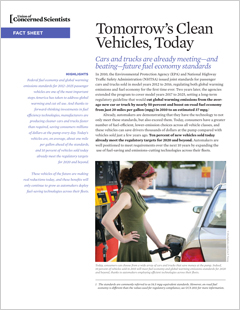A Ford F-150 that travels 5 miles further on every gallon of gas. A Mercedes crossover that saves drivers over $8,000 dollars in lifetime fueling costs. A Mitsubishi compact that gets 40 miles per gallon.
These aren’t fuel efficiency fantasies; they’re real numbers that represent new vehicles on the market today. Thanks to the Corporate Average Fuel Economy (CAFE) and global warming emission standards passed in 2010, today’s new cars and trucks are more efficient than ever before. And despite claims that the standards are expensive or technologically impossible, automaker manufacturers continue producing cleaner cars and trucks every year, saving consumers money and dramatically cutting carbon pollution.
The standards have been so successful that today’s new vehicles are, on average, about 1 mile per gallon ahead of their annual targets. About 10 percent of the vehicles sold today are a full five or more years ahead of schedule, meeting regulatory targets for 2020 and beyond. These include variants of six of the top 10 best-selling cars and trucks in the United States.
View some of these cars and trucks in the slideshow below, along with the fuel savings that increased fuel economy offers.
How the standards work
Under the CAFE standards, each vehicle is given a specific fuel efficiency target based on the vehicle’s size. Large vehicles like the Ford F-150 receive more modest targets than smaller, compact vehicles. Automakers are then assigned an average annual fuel economy target, based on the average target fuel efficiency of all the vehicles they sell for the year. Those annual targets slowly increase over time, and currently extend to 2025.
Automakers have met their targets by successfully incorporating a host of fuel-saving technologies, including turbocharged engines, transmission improvements, and electrification. Compared with vehicles from 2010, these and other innovations help save over 5 million gallons of fuel a day. That’s $9 billion in fuel savings since the standards were enacted—more than $12.3 million a day. In terms of carbon pollution, it’s equal to shutting down five coal-fired power plants permanently.
As more fuel-efficient vehicles hit the nation’s roads, the benefits of strong standards will only increase—steering us toward a better Half the Oil future.




